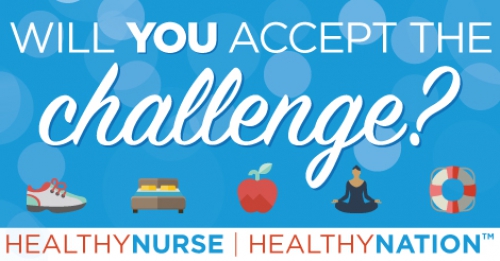Healthy Nurse, Healthy Nation™ Blog - Nurse Abuse — Why It Happens & How To Stop It
Published
Cynthia Coleman, RN, and Donna M. Fountain, PhD, RN share their experiences of workplace violence against nurses.
Cynthia Coleman, RN, experienced a danger at the start of her career. In the mid-1980s, she was in her early twenties and working at an inpatient psychiatric unit. A male patient became obsessed with her and upon his release from the hospital, found her address and went to her apartment. He left more than 30 messages on her answering machine demanding to know why she wasn’t home and detailing everything he saw looking into the window of her apartment. He even described her cat.
Fortunately, she checked her voicemail messages before leaving work, and went to a friend’s house instead of going to her place and facing the stalker. Coleman called the police but since the man didn’t have a criminal record and had known psychological problems, there was nothing they could do. Coleman promptly moved out of that apartment, but the patient continued to show up at the hospital where she worked. Eventually Coleman transferred to another department and paid to have her address and phone number unlisted.
Violence against nurses remains a critical issue
This harrowing story is just one of many. According to ANA’s 2013 – 2016 Heath Risk Appraisal, one quarter of nurses have been assaulted at work.* This startling statistic doesn’t even take into account situations like the one Coleman faced. Throughout her time as a nurse, Coleman has also been pushed during fights between patients and had a patient throw urine at her.
Why violence against nurses is so prevalent
“Nurses are at risk because we spend a lot of one-on-one time with the patients. We're doing more painful things to the patients. We're the ones that are giving them the drugs, or not giving them drugs, all of which can upset them,” says Coleman.
Dr. Donna Fountain, a nurse for more than 30 years and co-chair of the steering committee for ANA’s Professional Issues Panel to #EndNurseAbuse, has studied violence against nurses and bullying. She’s also had a pediatric patient’s father pull a gun on her in the emergency room, and another elderly demented patient choke her while she provided personal care. “Approximately 90 percent of nurses are female. Some people think that female employees are a safe place to vent anger and violent behaviors. As nurses, we often work in isolation with patients and in very close proximity to them. Plus socially, there is a lot of civil unrest in our culture right now,” says Fountain. All of these aspects can contribute to nurse abuse.
One reason violence against nurses continues is that many healthcare organizations do not take such reports seriously. This makes nurses hesitant to report issues and, as a result, the cycle continues. In fact, when Coleman was being stalked by a patient, the manager she told actually accused her of leading him on or not knowing how to brush him off. “There can be a moderate level of fear with reporting certain situations,” says Fountain.
What we can do
Fountain says that while any nurse may experience violence or bullying, studies suggest those in certain departments tend to face a higher incidence, including:
The most important thing we can do for nurses is to support them. “We need senior management, human resources, hospital security, and every employee to actively work together to prevent violence,” says Fountain. All reports of violence must be taken seriously and fully investigated.
Nurses as individuals also need to protect themselves. Some ways to do this include:
“As nurses, we’re taught to do no harm, so it’s difficult to take on a defensive stance with a patient,” says Fountain. But understanding that violence is an issue and proactively trying to prevent it or removing yourself from the situation may save your life.
What employers can do
Organizations that employ nurses must also step up to help their nurses stay safe. They can help by:
As Coleman says, “In our desire to be a professional, we think we have to deal with these situations. But no, we are a precious resource.”
What effective workplace violence prevention protocols are in place at your facility? How do you protect yourself on duty? Share your story in the discussion or in our private Facebook group.
Want to do more? Explore additional resources below:
Reviewed and updated 12/6/22
 Have you joined the Healthy Nurse, Healthy Nation (HNHN) Grand Challenge yet? Join us today!
Have you joined the Healthy Nurse, Healthy Nation (HNHN) Grand Challenge yet? Join us today!
Fortunately, she checked her voicemail messages before leaving work, and went to a friend’s house instead of going to her place and facing the stalker. Coleman called the police but since the man didn’t have a criminal record and had known psychological problems, there was nothing they could do. Coleman promptly moved out of that apartment, but the patient continued to show up at the hospital where she worked. Eventually Coleman transferred to another department and paid to have her address and phone number unlisted.
Violence against nurses remains a critical issue
This harrowing story is just one of many. According to ANA’s 2013 – 2016 Heath Risk Appraisal, one quarter of nurses have been assaulted at work.* This startling statistic doesn’t even take into account situations like the one Coleman faced. Throughout her time as a nurse, Coleman has also been pushed during fights between patients and had a patient throw urine at her.
Why violence against nurses is so prevalent
“Nurses are at risk because we spend a lot of one-on-one time with the patients. We're doing more painful things to the patients. We're the ones that are giving them the drugs, or not giving them drugs, all of which can upset them,” says Coleman.
Dr. Donna Fountain, a nurse for more than 30 years and co-chair of the steering committee for ANA’s Professional Issues Panel to #EndNurseAbuse, has studied violence against nurses and bullying. She’s also had a pediatric patient’s father pull a gun on her in the emergency room, and another elderly demented patient choke her while she provided personal care. “Approximately 90 percent of nurses are female. Some people think that female employees are a safe place to vent anger and violent behaviors. As nurses, we often work in isolation with patients and in very close proximity to them. Plus socially, there is a lot of civil unrest in our culture right now,” says Fountain. All of these aspects can contribute to nurse abuse.
One reason violence against nurses continues is that many healthcare organizations do not take such reports seriously. This makes nurses hesitant to report issues and, as a result, the cycle continues. In fact, when Coleman was being stalked by a patient, the manager she told actually accused her of leading him on or not knowing how to brush him off. “There can be a moderate level of fear with reporting certain situations,” says Fountain.
What we can do
Fountain says that while any nurse may experience violence or bullying, studies suggest those in certain departments tend to face a higher incidence, including:
- Emergency rooms
- Operating rooms
- Geriatrics (where patients may have Alzheimer’s or dementia)
- Psychiatric units
- Substance abuse treatment centers
The most important thing we can do for nurses is to support them. “We need senior management, human resources, hospital security, and every employee to actively work together to prevent violence,” says Fountain. All reports of violence must be taken seriously and fully investigated.
Nurses as individuals also need to protect themselves. Some ways to do this include:
- Familiarity with your facility’s workplace violence prevention policies and protocols
- Being aware of your surroundings at all times
- Proactively diffusing or removing yourself from a situation that could become violent
- Always knowing where all exits, telephones, and panic buttons are located
- Taking a self-defense class
- Participating in the CDC’s free course on workplace violence prevention
“As nurses, we’re taught to do no harm, so it’s difficult to take on a defensive stance with a patient,” says Fountain. But understanding that violence is an issue and proactively trying to prevent it or removing yourself from the situation may save your life.
What employers can do
Organizations that employ nurses must also step up to help their nurses stay safe. They can help by:
- Investigating all violent incidents and threats
- Implementing a zero-tolerance policy around violence
- Making sure all parts of the hospital are safe and secure, through additional security, access to panic buttons, corridor video surveillance, and well-lit hallways and rooms
- Constantly working to strengthen the programs and actions in place to deter and prevent violence
- Provide active-shooter training by trained professionals
As Coleman says, “In our desire to be a professional, we think we have to deal with these situations. But no, we are a precious resource.”
What effective workplace violence prevention protocols are in place at your facility? How do you protect yourself on duty? Share your story in the discussion or in our private Facebook group.
Want to do more? Explore additional resources below:
- Check out tips from our #ENDNURSEABUSE challenge!
- See updated statistics here.
- Check out ANA's Violence, Incivility, & Bullying webpages and sign the pledge to #EndNuseAbuse.
Reviewed and updated 12/6/22
 Have you joined the Healthy Nurse, Healthy Nation (HNHN) Grand Challenge yet? Join us today!
Have you joined the Healthy Nurse, Healthy Nation (HNHN) Grand Challenge yet? Join us today!
Blog Safety
08/14/2018 12:18pm CDT



Post a Comment or Question